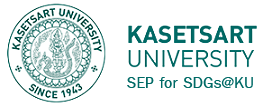
According to Kasetsart University’s announcement, energy conservation policy has been established as guidelines for all departments within the University for the efficient use of electricity, which is the main energy source in the operation of the university’s activities. Various measures are determined, such as the environmentally friendly design of buildings or structures or smart building using the Building Automation System (BAS) to manage energy within the building along with raising awareness of students and personnel in matters of energy conservation together with the policy of using more energy efficient electrical appliances to reduce energy consumption with the goal to replace 80 percent of all electrical appliances.
Finding alternative energy sources is another measure to reduce the use of electricity from fossil sources, such as Solar Power, Wind Power, Clean Biomass, Biogas, with a focus on being clean and environmentally friendly as well as indirectly reducing greenhouse gas emissions.
[2.11] Please provide total carbon footprint (CO2 emission in the last 12 months, in metric tons).
Kasetsart University Forests
Kasetsart University Forests plays an important role in the production of research. student Internship and academic services to the society as well as providing the ecosystem service for students, staff and visitors, as the source of greenhouse gases, water sources, conservation of plants and animals, etc. For the economy and society, it is the food banks, and the hiring place of local workers for distributing of the ecotourism to the community.
Kasetsart University Forest plays an important role as a recreation area and a source of carbon dioxide. Kasetsart University Forest at Chalermphrakiat Sakon Nakhon Province Campus is a community food bank for people to collect forest products.
1. Kasetsart University Bangkhen Campus with total area of forest 24.89 rai, absorbs carbondioxide of 21.25 tons per year.
1) Varunawan Park, 6 rai, absorbs 5.7 tons of carbon dioxide per year.
2) Thai Commemorative Garden, 4.6 rai, absorbs carbon dioxide absorbed 4.37 tons per year.
3) 100 years garden of Luang Suwan Vajokkasikij, 5.25 rai, absorbs carbon dioxide 4.99 tons per year
4) 60‐year garden, 6.52 rai, absorbscarbon 6.19 tons of carbon dioxide per year.
5) Arokaya Utthayan..2.5 rai.., absorbscarbon 2.09 tons of carbon dioxide per year.
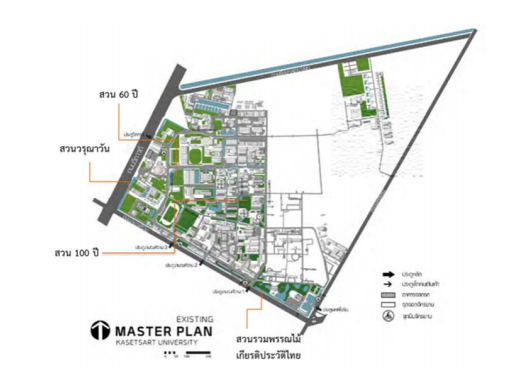
2. Kasetsart University Kamphaeng Saen Campus His Majesty the King’s 80th Birthday Anniversary Park, the area of 131 rai absorbs 124.45 tons of carbon dioxide per year.
3. Kasetsart University Chalermphrakiat Sakon Nakhon Province Campus H.M. Queen Sirikit’s 86th Birthday Anniversary Natural Park and Dipterocarp Forest with the area of 931 rai including of variety of species of the plants such as dipterocarp forest, Shorea siamensis Miq., Shorea obtuse Wall., Terminalia alata Heyne ex Roth., Buchanania latifolia Roxb., Aporusa avillosa Baill.,Xylia xylocarpa (Roxb.) Taub. , absorbs 884.45 tons of carbon dioxide per year.
4. Kasetsart University Sriracha Campus
Khao Nam Sap, 340 rai of a dry evergreen forest with notable species include Wrightia tomentosa Roem.,Lagerstroemia floribunda Jack.,Nephelium hypoleucum Kurz, absorbs 323 tons of carbon dioxide per year.
Assist. Prof. Dr. Ratchot Chompunich, Vice President for Strategic Development and Organizational Communication, Kasetsart University, participated in the event on “Hundred Hearts Unite to Reduce Global Warming” which organized by the Greenhouse Gas Management Organization (Public Organization), and received a certificate from Mr. Thaneadpon Thanaboonyawat, Secretary to the Minister of Natural Resources and Environment, which gave to Kasetsart University for organizing the carbon neutral events from the KU President Forum: Celebration of the 76th Anniversary of Kasetsart University. The special event was organized by the Office of the President of Kasetsart University.

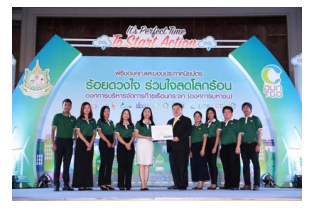
Assist. Prof. Dr. Rattanawan Mungkung, Director, along with researchers of the VGREEN team of the Faculty of Environment, Kasetsart University joined the event “Hundred Hearts Unite to Reduce Global Warming” organized by the Thailand Greenhouse Gas Management Organization (Public Organization), and received a certificate from Mr. Thaneadpon Thanaboonyawat, Secretary to the Minister of Natural Resources and Environment. Which is given to “Thai People Carbonless Heart (carbon‐neutral man)”, from assessing the annual greenhouse gas emission from daily activities, and buying carbon credits to compensate all to zero. This showed responsibility to society and environment, and helped reduce global warming.
The Green Library Network and the VGREEN team of the Faculty of Environment, Kasetsart University received a certificate of the “Thai People Carbonless Heart (carbon‐neutral man)” from assessing the annual greenhouse gas emission from daily activities, and buying carbon credits to compensate all to zero. The “Hundred Hearts Unite to Reduce Global Warming” event was organized by the Greenhouse Gas Management Organization (Public Organization).
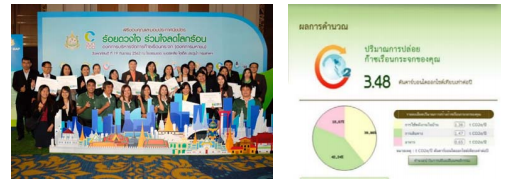

A training activity for internal energy auditors and the Carbon Footprint training course, under the Energy and Environment Management Program, in accordance with UI Green Metric criteria was organized by the Kasetsart University Library. The objective of the activities was to promote various activities related to energy and environmental conservation for personnel and users of the Kasetsart University Library.


KU Eco Green Campus
Kasetsart University is the first certified Thai university by Thailand Greenhouse Gas Management Organization (Public Organization), under the Thailand Voluntary Emission Reduction Program in forestry and green area category.
Thailand Greenhouse Gas Management Organization (Public Organization) organized an event on “Hundreds of Hearts to Reduce Global Warming” on 19 September 2018 at Vibhavadee Ballroom, Centara grand at Central Plaza Ladprao Bangkok. In this regards, H.E. General Surasak Kanchanarat, Minister of Natural Resources and Environment of Thailand presented a Plaque to Assoc. Prof. Dr. Trin Saengsuwan, Vice President for Kamphaeng Saen Campus for his achievement on KU Eco Green Campus project.
The project is registered as one of Thailand Voluntary Emission Reduction Program or T‐VER. Owing to Kamphaeng Saen Campus separated area of 235.77 rai within the campus into 3 zones for difference purposes as follows: Zone 1 – 100 rai of forest areaZone 2 – forest area Zone 3 –Yangnaa tree ( Dipterocarpus alatus Roxb.) planting area.
KU Forest for Life
Chalermphrakiat Sakon Nakhon Province Campus, Kasetsart University received a certificate of the event “Hundred Hearts Unite to Reduce Global Warming” which organized by the Thailand Greenhouse Gas Management Organization (Public Organization), in the category of Thailand Voluntary Emission Reduction Program (TVER).

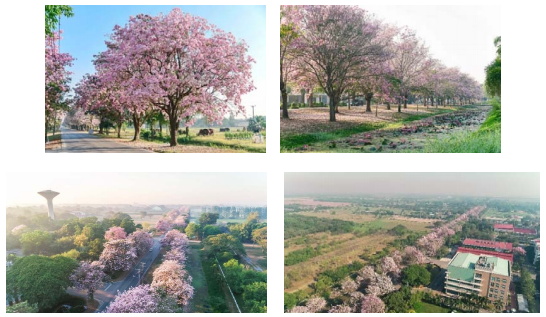
What is T‐VER?
Thailand Voluntary Emission Reduction Program or T‐VER was developed by Thailand Greenhouse Gas Management Organization (Public Organization) or TGO. The purpose is to promote and support all sectors to engage in greenhouse gas reduction voluntarily in order that the carbon credits obtained from the program can be trade. Credits obtained from the program are mainly used for CSR purposes and voluntary carbon offsets of organization and companies in Thailand. The TGO has defined rules and methodology to register and certify for the program that must be contributes to reducing / absorbing greenhouse gases in Thailand.
The number of 352 Pink Trumpet trees (Tabebuia rosea), or Chompooh Pantip in Thai, at amphaeng Saen Campus, Kasetsart University have been registered as the “Heritage of the Land” for the fiscal year 2019. This kind of tree was initiated grown in 1977 by Prof. Dr. Wattana Sathiensawat, the first Vice President for Kamphaeng Saen Campus at that time. He received the seed from Professor Rapee Sagarik, President at that time, which Professor Rapee brought the seeds from Singapore. Professor Wattana considered that growing of big trees would help obstruct strong wind and giving shade for the campus. Therefore, two sides of the roads within Kamphaeng Saen Campus were full of this kind of trees. Begin from the road in front of the Kasetsart University Laboratory School Kamphangsaen Campus ducational Research and Development Center to the Chandrubeksa Gate approximately 3 km. Until now, ink Trumpet trees are still growing and providing beautiful flowers every year in Kamphaeng Saen campus as these days.
On 14 September 2019, Dr. Chongrak Wachrinrat, Acting President of Kasetsart University, together with executive administrators, students, and personnel joined the event “KU Big Cleaning and Planting Trees Day 2019” at the area of Soi Phahon Yothin 45. The purpose of this activities was in honor of the auspicious occasion of the coronation of His Majesty King Maha Vajiralongkorn Phra Vajiraklaochaoyuhua in 2019. In addition, lead the representatives of the class of KU 79 students to planted trees at the garden of Rapee Sagarik Building. These activities managed to promote unity and raise awareness of personnel and students of Kasetsart University in taking care of buildings and locations. As well as keeping cleanliness, planting trees and looking after environment, to create a beautiful shady and a good landscape within Kasetsart University, Bang Khen Campus.
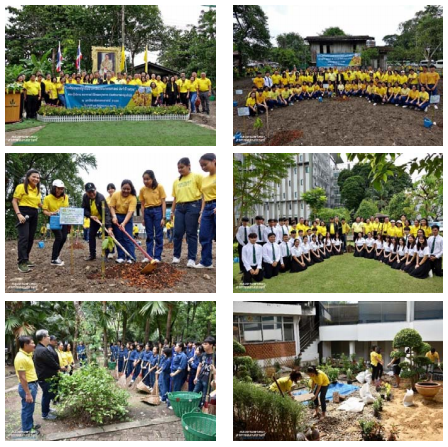
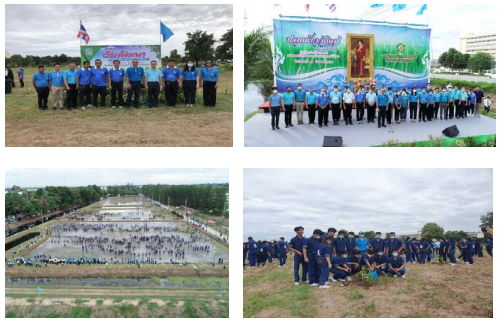
Tuesday 11 August 2020. Kasetsart University Kamphaeng Saen Campus organizes a rice planting project on Mother’s Day and Father’s Day. The area is used more than 13.5 rai at the fields (behind the fuel gas station). The campus development project is used 6 rai in the area of the civil servant flat at Kasetsart University, Kamphaeng Saen Campus, Nakhon Pathom Province. The objective to honor Queen Sirikit Queen Royal Princess Maha Chakri Sirindhorn on the occasion of the 88th Birthday Anniversary, 12 August 2020.
Kasetsart University has a policy to reduce greenhouse gas emissions into atmosphere, both direct and indirect, by supporting of library personnel to compensate for carbon credits and organizing carbon neutral events to help reduce global warming, for example, the KU President Forum: Celebration of the 76th Anniversary of Kasetsart University; the Kaset Fair, with an emphasis on the environment; and the “KU Big Cleaning and Planting Trees Day 2019, which is organized annually. The university aims to reduce greenhouse gas emission into atmosphere from both direct and indirect activities by 5 percent per year.
Greenhouse gas emit from various activities of human beings continuously. Including energy consumption, agriculture, industrial development and growth, transportation, and deforestation. As well destruction of natural resources and other forms of environment are all important causes of global warming day by day. The said problems became more severe from the effects of global warming. This makes countries, around the world, alert to reduce greenhouse gas emissions. The Carbon Footprint for Organization or Corporate Carbon Footprint (CCF) is a type of method to display the amount of greenhouse gases emitted from the organization’s operations, which will lead to the determination of management guidelines to reduce greenhouse gas emission effectively, both at the factory level,
industrial level, and national level.
Remark : All activities in 2.11refer to the Sustainable Development Goals (SDGs), otherwise known as the global goals, especially relating to Goal 13 Climate Action: Improve education, awareness‐raising and human and institutional capacity on climate change mitigation, adaptation, impact reduction and early warning.
